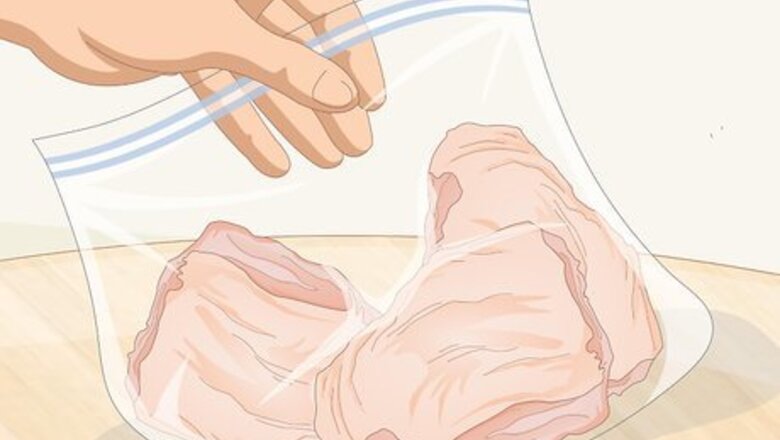
views
X
Trustworthy Source
HealthyChildren.org
Health information from the American Academy of Pediatrics.
Go to source
Pureed chicken is not only soft and easy for your baby to eat, but it’s also a great source of essential vitamins and minerals, like iron and zinc. To make chicken puree for your baby, you’ll need to cook it before adding it to a blender or food processor with a little liquid. You can make the puree more flavorful and nutritious by adding spices, juice, or your baby’s favorite fruit or vegetable.
Cooking the Chicken
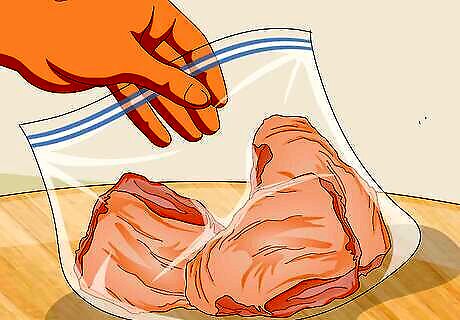
Select dark meat chicken for its high iron content. Breastfed babies benefit from eating foods that are rich in iron and zinc. While white chicken meat is leaner, dark meat is a better choice for your baby because it’s higher in iron and antioxidants. Go for a dark meat cut such as chicken thighs or leg quarters. Since most baby formulas are fortified with iron and other important micronutrients, it’s not as important for formula-fed babies to get the additional iron found in dark meat. Ask your pediatrician whether dark meat or white meat is a better choice for your baby. Chicken thighs are also higher in fat compared to the breasts, which makes them more flavorful and easier to puree. You will need 1-2 thighs to make about ½ cup (approximately 65 g) of cooked chicken. A single 6 oz (170 g) bone-in, skin-on thigh will yield about 3 ounces (85 g) of meat, but you’ll need more if you’re using small thighs.
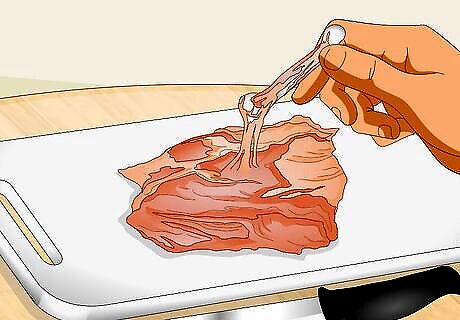
Remove any bones and skin from the chicken. If possible, purchase chicken meat that is already boneless and skinless. If that’s not available, peel off the skin and cut the meat off the bones. Chicken skin does not puree well. If you leave it on, you may end up with large pieces of skin in your puree, which could cause your baby to choke.
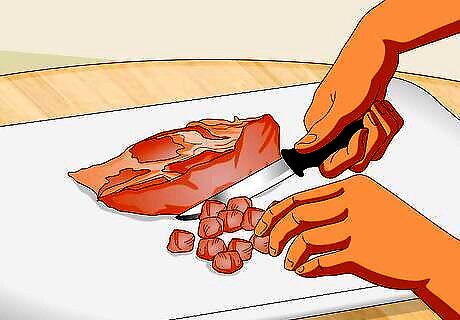
Dice the meat into small pieces. Before you cook the chicken, use a sharp knife to cut it into small cubes or dices. Put the chicken on a cutting board and slice it into strips about ⁄2 inch (1.3 cm) wide, then cut across the strips widthwise to make cubes. Putting the chicken in your freezer for 15 minutes before you slice it will make it easier to cut. Always take care when using a sharp knife. Keep your fingertips curled under when holding the chicken in place so you don’t accidentally cut them.
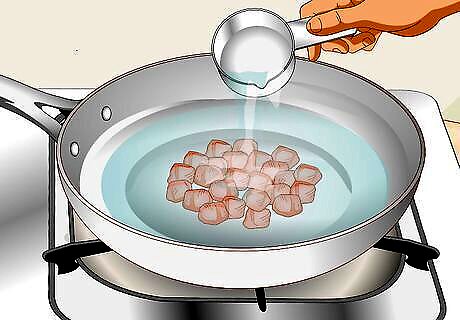
Cover the chicken with water or broth in a saucepan. Place your diced chicken in a pan and pour in enough water to completely cover the meat. Using broth will give the chicken a richer flavor, but it will also produce its own broth during the cooking process.Tip: If you prefer, you can roast the chicken or cook it in a crock pot instead of poaching it. Keep in mind that you may need to add more liquid to roasted chicken to create a smooth puree.
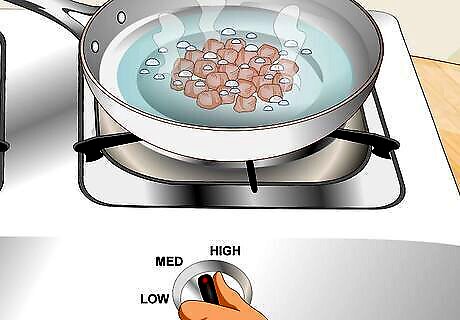
Bring the liquid in the pan to a boil. Place the pan on your stove and turn the burner on to medium-high heat. Cover the pan and wait for the liquid to begin boiling. The amount of time this takes will vary depending on how much liquid is in the pan. Check the pan frequently so you don’t lose track and overcook your chicken.
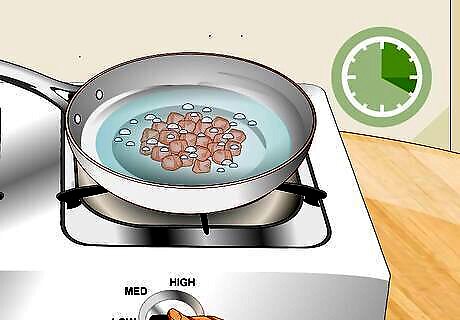
Turn the heat down and simmer the chicken for 15-20 minutes. Once the liquid begins to boil, turn the burner down to low. Cover the pot and allow the chicken to simmer until it is no longer pink and the juices run clear when you cut into it. This should take about 15-20 minutes. Take care not to overcook the chicken, or it will become tough and chewy. Always make sure the chicken is completely cooked through to an internal temperature of 165 °F (74 °C), or else it won't be safe to eat.
Making a Basic Chicken Puree
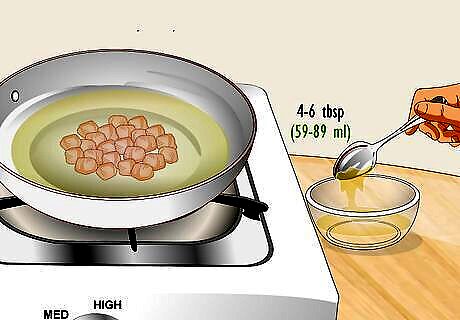
Set aside 4–6 tablespoons (59–89 mL) of the cooking broth. To get a smooth puree, you’ll need to add some liquid. Keep some of the broth so that you can add it to your blender or food processor when you puree the chicken. Using the cooking broth will add flavor and help restore some of the nutrients that were lost during the poaching process.Tip: If your baby hasn’t had chicken before, using the broth might make the flavor too strong. If they don’t like the taste, try pureeing chicken with water or juice instead.
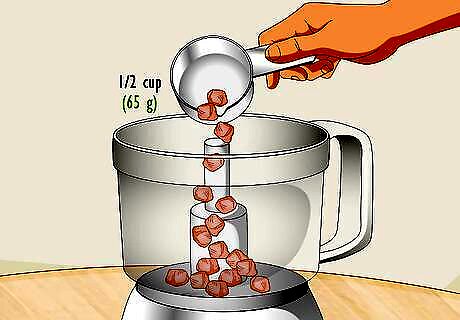
Put 1/2 cup (65g) of cooked chicken in a blender or food processor. Take your cubed, cooked chicken and place it inside the bowl of your food processor or blender. If you just cooked the chicken, give it a few minutes to cool first. Wait until the chicken is cool enough to comfortably touch. Be sure to assemble your blender or food processor before adding the chicken to the bowl!
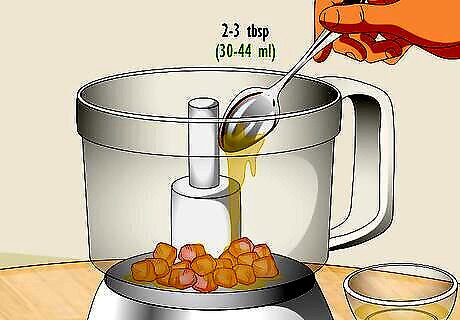
Add 2–3 tablespoons (30–44 mL) of liquid. Before you start blending, add a couple of spoonfuls of your broth to the bowl. This will moisten the chicken and help create a smooth puree. Don’t add all of the liquid at once. You may not need all of it, and adding too much can make your puree runny.
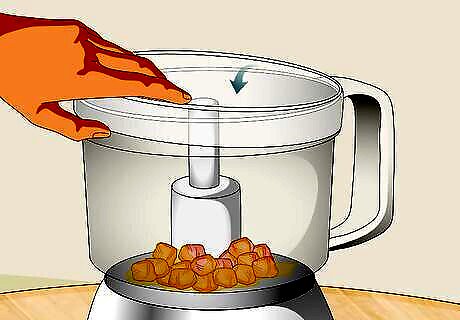
Put the cover on your blender or food processor. Don’t press any buttons until the cover is tightly in place. Otherwise, you’ll end up with a huge mess! Some food processors have a feed tube that allows you to add extra ingredients while the machine is running. If you don’t have this feature, you will have to stop the machine and uncover it to add any more liquid or other ingredients.
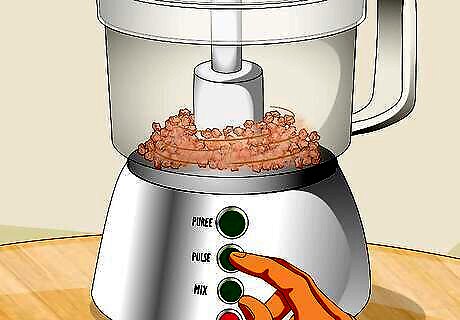
Hit the “pulse” button until the chicken is coarsely blended. Instead of going straight for the puree setting on your blender or food processor, hit “pulse” a few times to chop the meat up into smaller pieces. Using the “pulse” feature will help ensure that your chicken is evenly blended.

Puree the chicken until it is smooth. Switch to the “puree” setting and blend the chicken and broth until you achieve a smooth consistency. Check occasionally to see if the texture feels right and make sure the puree isn’t chunky or uneven. This process should only take a few minutes, but the time you need may vary depending on your blender or food processor.
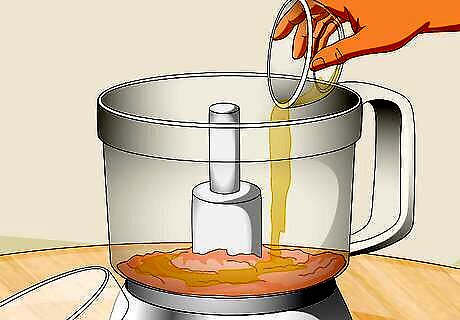
Add the rest of the liquid gradually if necessary. If there isn’t enough liquid, the puree may appear dry or grainy. If you think it needs more liquid, gradually mix in small amounts of your broth or water until you get the texture you want. Avoid adding too much liquid so your puree doesn’t get runny. If your puree does become too runny, you can thicken it by adding more chicken. Expert Answer Q When should babies start eating meat? Monica Moreno, MS, RD, LD/N Monica Moreno, MS, RD, LD/N Registered Dietitian Monica Moreno is a Registered Dietitian and the Founder, Owner, and Lead Dietitian at Essence Nutrition in Miami, Florida. Monica specializes in nutrition consulting and school and corporate wellness programs. She holds a BA from The University of Florida and an MS in Dietetics and Nutrition from Florida International University. Monica was the dietitian for the Miami Marlins for close to 5 years, and she is currently visiting dietitian specialist at Ocean Reef Resort and Club. Monica is a member of the Academy of Nutrition and Dietetics, Nutrition Entrepreneurs Dietetics Practice Group, Integrative Nutrition Dietetics Practice Group, Collegiate and Professionals Sports Dietitians Association, and Weight Management Dietetic Practice Group. She was awarded the 2020 Coral Gables Chamber of Commerce Business Woman in Healthcare of the Year award. Monica Moreno, MS, RD, LD/N EXPERT ADVICE Answer from Monica Moreno, MS, RD, LD/N: Babies should start eating meat when they're around 6 months old. The baby's iron stores originally come from their mom, but they start to level off at the 6-month mark. Because of this, the infant needs other sources of iron.
Adding Other Flavors
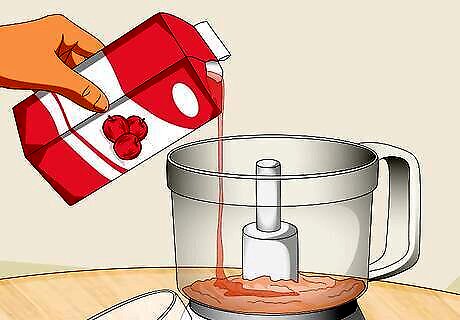
Substitute juice for water or broth to create a different flavor. If your baby doesn’t like the taste of pure chicken puree, using a different liquid can help disguise or enhance the flavor. Try using a little apple or white grape juice instead of broth or water, or mix the juice and broth together. To avoid giving your baby too much sugar, use 100% unsweetened juice.
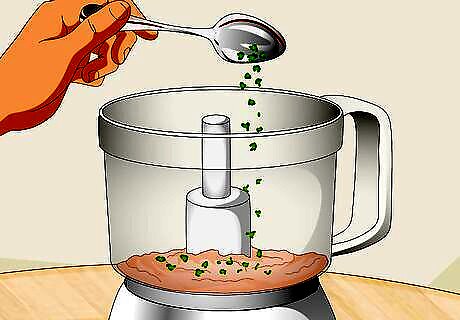
Add some mild herbs or spices for extra zest. Although you may be hesitant to feed your baby anything with spices in it, experimenting with a variety of flavors and textures will help them develop a more adventurous palate. Add a pinch of a mild seasoning, such as black pepper, garlic powder, basil, or rosemary to enhance the taste of your puree.Tip: You can add fresh or dried herbs to your baby’s food. If you use fresh herbs, make sure to puree the leaves well so that there are no big pieces your baby might choke on. Use a small amount of any seasoning at first so that your baby can get used to the new flavor. Wait to try this until your baby has already tried pure chicken puree, and only experiment with 1 seasoning at a time. If your baby is allergic to a food or seasoning, this will make it easier to tell which ingredients to avoid in the future.
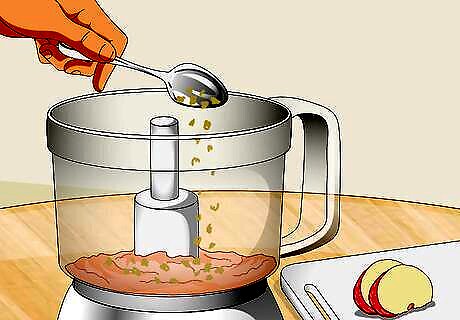
Mix in your baby’s favorite fruit or vegetable for added nutrients. You can make your puree even more tasty and nutritious by combining the chicken with a variety of fruits and veggies. Before pureeing fruits or vegetables, dice them into small cubes and cook them until they are tender. Steaming your fruits or vegetables rather than boiling them will help them taste better and retain more of their nutrients. Add about 1/4 cup (approx. 45 g) of the cooked fruits vegetables to the blender or food processor along with the chicken. Try combining chicken with apples, pears, carrots, sweet potatoes, peas, or spinach. Only experiment with 1 new ingredient at a time so that you can easily identify any foods your baby is allergic to.




















Comments
0 comment